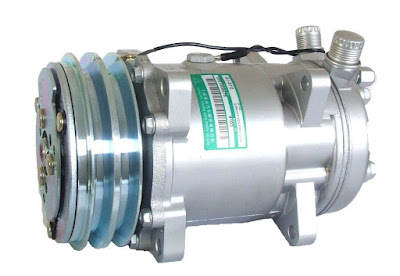Air Conditioner Compressor Guide
The typical air conditioning service call would cost over $100. We will show you how to correctly troubleshoot your unit and avoid unnecessary replacement. This procedure will help you to check out the typical single speed units.
There are basically four types of compressors that are used in air conditioning systems. A rotary compressor is commonly used in window units and some central ac units. They have been around for many years and are inexpensive and durable. A reciprocating compressor is the most common in lower efficiency split air conditioners. They are relatively inexpensive but not as durable. A scroll compressor is the most common type in higher efficiency equipment. They are very durable and efficient but are typically more expensive. The latest innovation is variable speed compressors which are commonly referred to as inverter drives. These are in the top of the line high efficiency units but they are normally the most expensive.
First, we will check to ensure that the compressor does not have an electrical problem. You will need a basic multimeter to measure resistance.
Shut off the power to the unit and verify with the meter that no power is present. Next, you need to remove the terminal cover. Check to make sure that the wires and the terminals are not damaged.
The typical unit will have three terminals labeled C, R, and S. You should check for continuity (less than 30 ohms resistance) between C & R, C & S, and R & S.
If the resistance is significantly higher, then check to see if the compressor is hot. If the unit is hot, the internal overload is open. You will need to wait until it cools off to continue troubleshooting.
If the resistance reading is high and the unit is cool to the touch, the compressor motor is bad.
Next, you should take resistance readings from each of the terminals to the body of the compressor. A low resistance reading, means the motor is grounded and the compressor will need replaced.
You should also check the capacitors. If your tests do not indicate a bad compressor motor but the unit trips the breaker or fuse, the problem may be mechanical.
In some cases, as the unit gets older it may require a boost to get started. Special capacitors called hard start capacitors are made for these situations. They are a combination of a capacitor and a built in relay. They give the compressor extra starting torque and the relay disconnects the capacitor after the unit starts. They are very inexpensive and can often extend the life of the compressor for several years.
If you install a hard start capacitor and the unit will still not start, you will need to proceed with air conditioner compressor replacement.
In other cases, the air conditioner compressor may run but not provide cooling. This can happen when a failure allows liquid refrigerant instead of vapor at the compressor inlet. The result is usually broken valves in the compressor. In that case, the air conditioner compressor or the whole condensing unit will require replacement.
The basic process of air conditioner compressor replacement begins with shutting off the power to the unit and recovering the refrigerant from the system. This is required in the United States for compliance with EPA regulations. A recovery unit is connected to the system and the refrigerant is pumped into a storage cylinder. Mark the leads and disconnect them from the terminals.
Then, the copper lines connected to the inlet and outlet of the old compressor are cut loose. The mounting bolts are removed from the base of the unit and it is removed.
The new compressor is then mounted in the unit with the mounting bolts. The copper lines are then brazed to the inlet and outlet as dry nitrogen is purged through the system. A liquid line filter/drier should be installed anytime the refrigerant system is opened to the atmosphere. A suction line filter should be installed on the unit if acid was detected.
After the system is sealed, it should be pressurized with dry nitrogen and checked for leaks. Then, a vacuum pump should be connected and the system should be evacuated. It is a good idea to leave the vacuum pump running for several hours.
The electrical wires should be reconnected to the terminals.
Then, the vacuum pump should be removed and refrigerant introduced to the system. The power to the unit should then be turned on and the system ran to get the proper amount of refrigerant in the system. You can use our air conditioner charging guide to check the total system charge.




评论
发表评论